Effective Techniques for Using Expanding Drywall Anchors in Home Projects
Understanding Expanding Drywall Anchors A Comprehensive Guide
When it comes to hanging items on drywall, the right hardware is crucial. For many, the go-to solution is the expanding drywall anchor, a versatile and effective option that can support a variety of weights depending on the type chosen. Whether you’re hanging shelves, artwork, or heavy fixtures, understanding how expanding drywall anchors work and selecting the correct type is essential for a successful installation.
What are Expanding Drywall Anchors?
Expanding drywall anchors are specialized fasteners that provide support for loads attached to drywall. Unlike traditional screws, which can easily pull out of drywall, expanding anchors grip the drywall and distribute the weight more effectively. They come in various materials and designs, but the most common types include plastic expansion anchors and metal toggle bolts.
Plastic Expansion Anchors
These are typically made from durable plastic and work well for lighter applications. The installation process involves drilling a hole into the drywall, inserting the anchor, and then driving a screw into the anchor. As the screw pulls the anchor against the wall, it expands, filling the space within the drywall and providing a secure hold.
Metal Toggle Bolts
For heavier items, metal toggle bolts are often recommended. These consist of a screw with a spring-loaded toggle that opens up within the wall cavity. When the screw is inserted, the toggle expands, creating a firm grip against the back of the drywall. This type of anchor can support significantly more weight and is ideal for hanging heavier shelves or fixtures.
How to Choose the Right Expanding Drywall Anchor
Choosing the right expanding drywall anchor depends on several factors
1. Weight Capacity Different anchors have various weight limits. Always check the packaging or product specifications to ensure the anchor can support the intended load. For example, a light plastic anchor may support 10-25 pounds, while a toggle bolt can support 50 pounds or more.
2. Type of Fixture Consider what you are hanging. For light frames or pictures, plastic anchors are often sufficient. For heavy shelves or mirrors, a stronger metal toggle bolt is likely a better choice.
expanding drywall anchor

4. Ease of Installation Some anchors are easier to install than others. While plastic anchors generally require only a drill and screwdriver, toggle bolts may need a little more dexterity due to their dual components.
Installation Tips
Proper installation is critical to maximize the effectiveness of the anchor
1. Measure Twice Before drilling, ensure you measure the position of the hanging item accurately. This will help you avoid unnecessary holes in the drywall.
2. Drill the Correct Size Hole Refer to the size recommendations on the anchor packaging. Drilling the correct hole will help the anchor expand properly.
3. Do Not Over-tighten If you're using a screw with the anchor, be cautious not to over-tighten. This can strip the hole or break the anchor.
4. Use A Level For shelves or frameworks, ensure that they are level during installation. A crooked installation can lead to additional stress on the anchors.
Common Use Cases
Expanding drywall anchors are versatile and can be used in numerous applications, including
- Hanging picture frames - Installing shelves - Mounting televisions - Securing curtain rods - Attaching mirrors
By selecting the right type of anchor and following proper installation techniques, you can ensure that your fixtures remain securely in place, regardless of their weight.
Conclusion
Expanding drywall anchors are a reliable solution for hanging items on drywall. Understanding the different types, choosing the right one for your project, and ensuring proper installation will make the process seamless. Whether you're a DIY enthusiast or simply looking to hang a few pictures, expanding drywall anchors can provide the support you need for a successful installation. With some knowledge and the right tools, you can enhance your living space with confidence.
-
Weatherproof Plastic Expansion Anchors for OutdoorNewsJun.06,2025
-
Sustainability in the Supply Chain: Eco-Friendly TEK Screws ProductionNewsJun.06,2025
-
Load-Bearing Capacity of External Insulation FixingsNewsJun.06,2025
-
Double Head Bolts: Enhancing Efficiency in Industrial MachineryNewsJun.06,2025
-
Corrosion Resistance in Chipboard Screws: Coatings for Wholesale DurabilityNewsJun.06,2025
-
Butterfly Toggle Bolts : Enhancing Structural ResilienceNewsJun.06,2025
